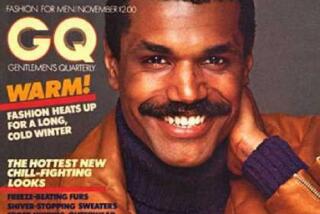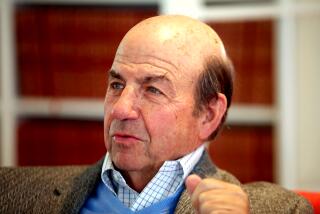Men’s magazines go at it like gladiators
Spilling from newsstands on every corner here, magazines reveal a world that is aggressive and glossy, bursting with talk of sex and beauty, BVDs and DVDs, mountains of chocolate cake and rivers of lip gloss. And on every cover a celebrity -- J-Los and Toms cruising everywhere.
Yet this vivid and varied world is born inside a few office towers along 15 blocks of midtown Manhattan. It is here that magazines are conceived and created; here they are tested and marketed; here their editors and acolytes live, lunch and trade jobs; here that conglomerates Conde Nast and Hearst, AOL Time Warner and Hachette/Filipacchi exist side by side, warring states in a Balkan empire.
These days, the men’s books are getting attention for sparring with an undisguised hostility worthy of gladiators.
A couple of hundred people run the entire magazine industry, and primarily they watch each other all day. It’s a very internal conversation: They are all driven by the same market research; they are all under the same pressure to be hip and to confront the reality that most of their readers are spending an increasing amount of time on the Internet; they all read Page Six gossip and Keith Kelly’s media column in the New York Post; and they all eat lunch at about a dozen restaurants including Michael’s, the Palm, and DB Bistro, where they regularly scarf down $28 hamburgers.
And what about the rest of the country? Who cares. As one wise media man says, “When one touches an ice cube, the other twitches. That’s what they care about.”
A secret aching for sameness creates bizarre competitions among these magazine people. And so dozens of fashion-obsessed editorial assistants at Elle, Vogue and Harper’s Bazaar -- young, female and starving -- vied last spring to own (get ready) a pair of green, Balenciaga cargo pants that at full price would have cost about $900. This is all part of the illusion magazine divas perpetuate, that they alone can keep America up to speed on what is the best/hippest thing -- be it pants, sex, couches, CDs or emotional crises.
A rare emissary among the rivals is the Post’s columnist Kelly. Twice a week, he chronicles this world in several short items that are read first thing in the morning and analyzed over lunch. Often, he reports job changes before the departing editor has a chance to announce to his staff he’s defecting.
Five years ago, Mark Golin, a funny, chain-smoking editor in his late 30s, left a smallish publishing company in Allentown, Pa., to work in this capital of cheeky cover lines and vodka ads. First, Golin worked for Hearst’s aggressively submissive Cosmopolitan; then he went over to upstart Dennis Publishing to run testosterone-pumped Maxim; eventually, he upgraded to Conde Nast’s slightly fey Details.
But before Golin even had a chance to tell the frat boys at Maxim he was jumping ship to lead the stylish boys at Details, columnist Kelly described his departure in his column. (Golin has since moved to AOL and is now on loan to Time Inc., home of about 130 magazines, to dream up a new template for men’s magazines. As if.)
“My theory is in some ways I cover a small town, its ins and outs, winners and losers,” Kelly said. “And every now and then there’s a real juicy murder.”
Although he’s just a beer-drinking guy from Brooklyn who wouldn’t be caught dead summering in the Hamptons, Kelly relishes setting swank insider scenes. He was the first to report a lunch in April at the celebrity-populated Da Silvano (think Uma, Gwyneth and Calvin) between Art Cooper, GQ’s editor, and John Huey, the editorial director of AOL Time Warner’s magazines. Cooper wanted Huey to cooperate with a GQ writer assigned to write a profile of him; Huey, who hadn’t been in his job even a year, wanted Cooper to delay the piece. Neither got what he wanted; Kelly described the meeting in absorbing detail in the next day’s paper, and a scathing profile of Huey, who runs one of Conde Nast’s chief competitors, appears in the December issue of Conde Nast’s GQ.
And so it has gone for years, with magazines nibbling at each other’s advertising revenues, flanking each other by coming in younger and hipper month to month, and slavishly courting advertising agencies located in office towers along another 15 blocks of midtown Manhattan.
Sometimes, however, somebody does do something, well, sort of different.
In 1997, for example, the men’s competition heated up when Felix Dennis, an eccentric British publisher, sent a scout to New York to investigate whether so-called British laddie boy magazines, anchored by busty blonds and goof-ball humor, would make it in the United States.
In no time, Maxim had rented a purposely un-GQ office suite decorated with fish tanks and girly posters, and the new magazine was blanketing newsstands with more attitude, more sex, more style and of course lots more almost-naked chicks. The literate and respected GQ and Esquire looked stuffy by comparison. And really, it wasn’t the sex that was most threatening to these great men’s glossies and appealing to the advertisers. It was the message -- we’re hipper and we serve up surprises every month. Maxim’s circulation now surpasses GQ’s and Esquire’s combined.
At lunch this week, Maxim Editor in Chief Keith Blanchard, who is 36, drank two rum and Cokes and dug through a hefty bowl of pasta while explaining Maxim’s success and constantly taking shots at GQ, its prime competitor.
“We don’t consider ourselves journalists like they do at GQ,” he said. “We’re entertainers and we know guys have short attention spans and rather than fight that, we want to affirm it. We’re not trying to impress anybody at an awards luncheon. We’re trying to have fun.”
With a 2.5-million circulation and more than $150 million in ad revenues last year, Maxim has clearly found enough 20-something guys with attention deficit syndrome to read, as its cover announces, about “sex, sports, beer, gadgets, clothes.”
Over at the Conde Nast tower with its Frank Gehry-designed cafeteria, no one at the very sleek GQ was willing to talk on the record about the competition. Although GQ remains satisfied with its 756,000 circulation and growing ad revenues, a highly placed Conde Nast source did find just a few minutes before speeding off to a black-tie dinner to provide a copy of Maxim with a dozen yellow Post-its on pages he found notable for being misogynistic. Some of it is ugly. Mostly, it’s tasteless. “When the Maxim readers grow out of this trash,” he said, “GQ will be there as it has been for 45 years to show them the way.”
But Jon Katz, media critic and author, doesn’t think the self-absorbed magazine industry is doing its readers nor itself any favors with this feuding.
“The regular Joe is bald, fat, horny and pissed off at his boss and henpecked by his wife,” said Katz. “The average guy is not one-tenth as stylish as a GQ guy or a Maxim guy.”
Katz thinks the magazines will do themselves in someday if they don’t leave those 15 blocks and start asking important questions about men.
“Nobody is sitting around those restaurants asking how can we really serve men better, how can we find out what they are really worried about. Instead, these guys are just marketing hipness. In the long haul, they’ll be sacrificed to their own obsessive love at being temporal.”
More to Read
Sign up for our Book Club newsletter
Get the latest news, events and more from the Los Angeles Times Book Club, and help us get L.A. reading and talking.
You may occasionally receive promotional content from the Los Angeles Times.







